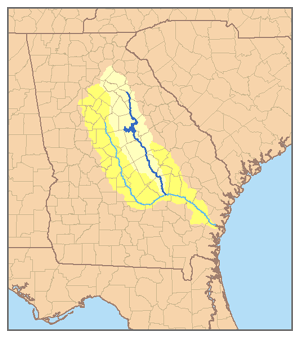Oconee River facts for kids
The Oconee River is a long river in the state of Georgia, USA. It stretches about 220 miles (354 km). The river starts in Hall County. It flows south until it meets the Ocmulgee River. Together, they form the Altamaha River near Lumber City. This meeting point is where Montgomery, Wheeler, and Jeff Davis counties meet.
Near Athens, two smaller rivers, the Middle Oconee River and North Oconee River, join together. These two rivers flow for about 55 to 65 miles (88 to 105 km) before they meet. They then form the main Oconee River. Milledgeville, which used to be Georgia's capital city, is located right on the Oconee River.
The Oconee River Greenway is a popular trail along the river in Milledgeville. It opened in 2008. Another part of this trail, the North Oconee River Greenway, is in Athens.
Contents
The Oconee River's Journey
The Oconee River flows through the Oconee National Forest. It then enters Lake Oconee, which is a lake made by people. This lake is near the towns of Madison and Greensboro, close to Interstate 20.
From Lake Oconee, the river continues to Lake Sinclair. This is another man-made lake located in Milledgeville. Milledgeville was built on Georgia's Fall Line. South of Milledgeville, the river flows freely. It eventually joins the Ocmulgee River to create the Altamaha River.
Along the Oconee River, you can find many sandbars. There are also oxbow lakes, which are U-shaped lakes formed when a river changes course. The forest swamps around the Oconee River stretch for miles. This creates a very quiet and natural area.
What Does "Oconee" Mean?
The name of the Oconee River comes from a group of people called the Oconee. They were a Muskogean people who lived in central Georgia. The Oconee people used to live in what is now Baldwin County, Georgia. Their settlement was known as Oconee Old Town.
In the early 1700s, the Oconee people moved to the Chattahoochee River. The name "Oconee" can be spelled in a few different ways. These include Ocone, Oconi, Ocony, and Ekwoni.
Keeping the Oconee River Clean
Rivers can sometimes get dirty from pollution. The Oconee River has faced some challenges with pollution. It is important to understand what causes this and how people are working to keep the river healthy.
Sources of River Pollution
One type of pollution comes from bacteria called fecal coliform. These bacteria are found in the waste of humans and animals. They can get into the river in several ways. This includes rainwater runoff from farms and pet waste. Leaky pipes and sewer spills can also cause these bacteria to enter the water. It is important to know that fish caught in the Oconee River can be eaten if they are cooked very well.
Another common pollutant in the river is fertilizer. Fertilizers contain things like nitrogen. When too much nitrogen gets into the water, it can make a lot of algae grow. This can harm the river's ecosystem.
A third type of pollution is called sedimentation. This happens when soil and dirt wash into the river. It is often caused by construction or the growth of towns and cities. Keeping the river clean helps protect the plants and animals that live there.
Bridges Over the Oconee River
Many bridges cross the Oconee River, helping people travel across it.
Oconee River Bridge
South of Milledgeville, there is an important bridge called the Oconee River Bridge. During the American Civil War, this bridge was a site of resistance. Soldiers from the Fourth Kentucky Regiment fought here. They were joined by a group of convicts and cadets from the Georgia Military Institute. They tried to stop a Union army group during Sherman's March to the Sea.
Herschel Lovett Bridge
The Herschel Lovett Bridge is a steel girder bridge that crosses the Oconee River. It connects the cities of Dublin and East Dublin. This bridge carries several important roads, including US 80, US 319, SR 26, SR 29, and SR 31. The bridge was named after Herschel Lovett, who was a businessman and politician from Dublin.
See also
 In Spanish: Río Oconee para niños
In Spanish: Río Oconee para niños


